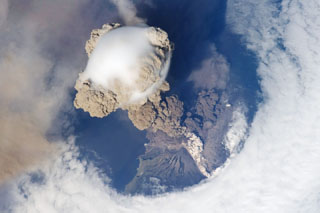Report on Sarychev Peak (Russia) — October 1976
Natural Science Event Bulletin, vol. 1, no. 13 (October 1976)
Managing Editor: David Squires.
Sarychev Peak (Russia) Ash emission and lava flows
Please cite this report as:
Global Volcanism Program, 1976. Report on Sarychev Peak (Russia) (Squires, D., ed.). Natural Science Event Bulletin, 1:13. Smithsonian Institution. https://doi.org/10.5479/si.GVP.NSEB197610-290240
Sarychev Peak
Russia
48.092°N, 153.2°E; summit elev. 1496 m
All times are local (unless otherwise noted)
Ash emission, accompanied by earth tremors and a booming noise, began in mid-September. On 2 October, volcanologists observed two lava flows moving rapidly down the W flank toward the Sea of Okhotsk. By 16 October, eruptive activity was limited to infrequent "smoke" effusion, allowing the staff of the hydro-meteorological station (the only inhabitants of the island) to return. Volcanologists from the Institute of Volcanology, Petropavlovsk (IVP) are presently studying the volcano. Sarychev had a mild ash eruption lasting only 6 minutes on 9 December 1965. Its last major eruption began on 30 August, 1960, producing a 5-km-high cloud of andesitic basalt ash.
Further Reference. Andreyev, V.N., Shantser, A.Ye., Khrenov, A.P., Okrugin, V.M., and Nechayev, V.N., 1978, Eruption of the volcanic peak Sarycheva in 1976: Byull. Vulkanol. Stn., no. 55, p. 35-40.
Geological Summary. Sarychev Peak, one of the most active volcanoes of the Kuril Islands, occupies the NW end of Matua Island in the central Kuriles. The andesitic central cone was constructed within a 3-3.5-km-wide caldera, whose rim is exposed only on the SW side. A dramatic 250-m-wide, very steep-walled crater with a jagged rim caps the volcano. The substantially higher SE rim forms the 1496 m high point of the island. Fresh-looking lava flows, prior to activity in 2009, had descended in all directions, often forming capes along the coast. Much of the lower-angle outer flanks of the volcano are overlain by pyroclastic-flow deposits. Eruptions have been recorded since the 1760s and include both quiet lava effusion and violent explosions. Large eruptions in 1946 and 2009 produced pyroclastic flows that reached the sea.
Information Contacts: Tass.

